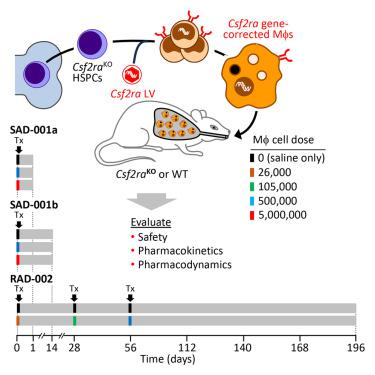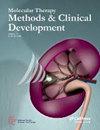Csf2ra 互补和肺巨噬细胞移植治疗遗传性 PAP 小鼠毒理学研究
IF 4.6
2区 医学
Q2 MEDICINE, RESEARCH & EXPERIMENTAL
Molecular Therapy-Methods & Clinical Development
Pub Date : 2024-02-17
DOI:10.1016/j.omtm.2024.101213
引用次数: 0
摘要
肺巨噬细胞移植(PMT)是一种基因和细胞移植方法,目前正开发用于治疗遗传性肺泡蛋白沉着症(hPAP),这是一种由(和鼠类同源物)突变引起的表面活性物质蓄积症。我们对基因校正巨噬细胞(mGM-RαMϕs)的 PMT 或生理盐水对照干预或野生型(WT)小鼠进行了毒理学研究,包括单次升剂量和重复升剂量研究,以评估安全性、耐受性、药代动力学和药效学。慢病毒介导的 cDNA 转导恢复了 mGM-RαMϕs 的 GM-CSF 信号传导。在 PMT 之后,mGM-RαMϕs 接种并留在肺内,没有发生不受控制的增殖,也没有导致支气管痉挛、肺功能异常、肺部或全身炎症、抗转基因产物抗体或肺纤维化。在生理盐水和 PMT 处理的小鼠中,攻击性雄性打斗导致的严重不良事件发生率同样很低。在使用安全边际剂量而非目标剂量(分别为 5,000,000 或 500,000 mGM-RαMϕs)的 PMT 14 天后,仅在小鼠而非 WT 小鼠中观察到短暂、轻微的肺中性粒细胞增多和原有的 hPAP 相关淋巴细胞增多症加重。PMT 降低了小鼠肺病的严重程度。结果表明,mGM-RαMϕs PMT 对小鼠是安全、耐受性良好和有疗效的,并确定了无不良反应水平和 10 倍的安全系数。本文章由计算机程序翻译,如有差异,请以英文原文为准。

A toxicology study of Csf2ra complementation and pulmonary macrophage transplantation therapy of hereditary PAP in mice
Pulmonary macrophage transplantation (PMT) is a gene and cell transplantation approach in development as therapy for hereditary pulmonary alveolar proteinosis (hPAP), a surfactant accumulation disorder caused by mutations in (and murine homologs). We conducted a toxicology study of PMT of gene-corrected macrophages (mGM-RαMϕs) or saline-control intervention in or wild-type (WT) mice including single ascending dose and repeat ascending dose studies evaluating safety, tolerability, pharmacokinetics, and pharmacodynamics. Lentiviral-mediated cDNA transfer restored GM-CSF signaling in mGM-RαMϕs. Following PMT, mGM-RαMϕs engrafted, remained within the lungs, and did not undergo uncontrolled proliferation or result in bronchospasm, pulmonary function abnormalities, pulmonary or systemic inflammation, anti-transgene product antibodies, or pulmonary fibrosis. Aggressive male fighting caused a similarly low rate of serious adverse events in saline- and PMT-treated mice. Transient, minor pulmonary neutrophilia and exacerbation of pre-existing hPAP-related lymphocytosis were observed 14 days after PMT of the safety margin dose but not the target dose (5,000,000 or 500,000 mGM-RαMϕs, respectively) and only in mice but not in WT mice. PMT reduced lung disease severity in mice. Results indicate PMT of mGM-RαMϕs was safe, well tolerated, and therapeutically efficacious in mice, and established a no adverse effect level and 10-fold safety margin.
求助全文
通过发布文献求助,成功后即可免费获取论文全文。
去求助
来源期刊

Molecular Therapy-Methods & Clinical Development
Biochemistry, Genetics and Molecular Biology-Molecular Biology
CiteScore
9.90
自引率
4.30%
发文量
163
审稿时长
12 weeks
期刊介绍:
The aim of Molecular Therapy—Methods & Clinical Development is to build upon the success of Molecular Therapy in publishing important peer-reviewed methods and procedures, as well as translational advances in the broad array of fields under the molecular therapy umbrella.
Topics of particular interest within the journal''s scope include:
Gene vector engineering and production,
Methods for targeted genome editing and engineering,
Methods and technology development for cell reprogramming and directed differentiation of pluripotent cells,
Methods for gene and cell vector delivery,
Development of biomaterials and nanoparticles for applications in gene and cell therapy and regenerative medicine,
Analysis of gene and cell vector biodistribution and tracking,
Pharmacology/toxicology studies of new and next-generation vectors,
Methods for cell isolation, engineering, culture, expansion, and transplantation,
Cell processing, storage, and banking for therapeutic application,
Preclinical and QC/QA assay development,
Translational and clinical scale-up and Good Manufacturing procedures and process development,
Clinical protocol development,
Computational and bioinformatic methods for analysis, modeling, or visualization of biological data,
Negotiating the regulatory approval process and obtaining such approval for clinical trials.
 求助内容:
求助内容: 应助结果提醒方式:
应助结果提醒方式:


